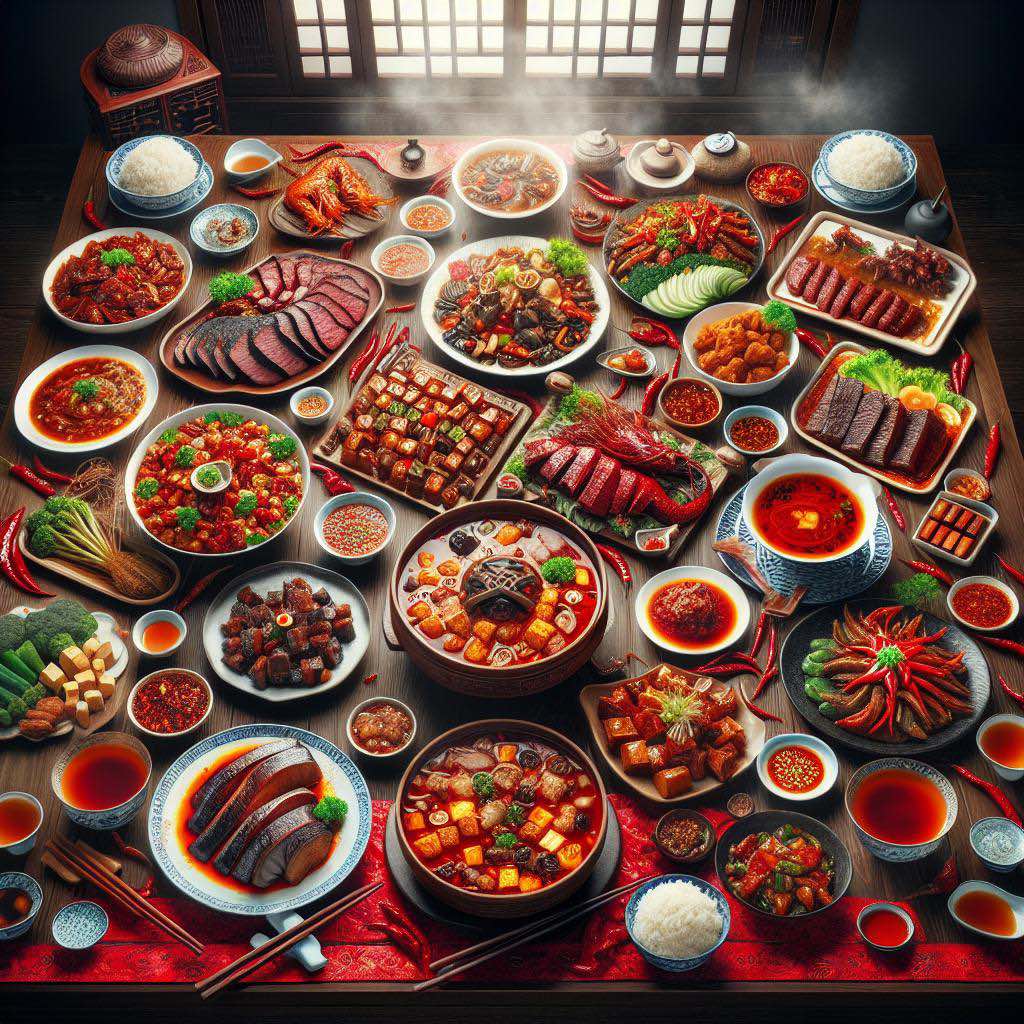
Introduction to Hunan Cuisine
Hunan cuisine, also known as Xiang cuisine, hails from the central region of China, characterized by its spicy, sour, and fragrant flavors. Unlike Sichuan cuisine, which uses numbing peppercorns, Hunan cuisine focuses on pure heat from fresh chilies and layers of vinegar, garlic, and fermented ingredients. This cuisine offers a vibrant balance between spice, freshness, and strong flavors, making it one of the most distinct and exciting styles in Chinese cooking.
Hunan cuisine is often compared to Sichuan cuisine, but it stands out for its bold, direct flavors and reliance on fresh ingredients. The dishes are known for their use of pickling, smoking, and drying techniques, as well as their intense heat levels.
Key Ingredients in Hunan Cuisine
Hunan cuisine incorporates several ingredients to create its signature heat and sour notes:
- Fresh Chilies: A hallmark of Hunan cooking, fresh chilies are used in almost every dish.
- Fermented Black Beans: Adds depth and savory flavor to stir-fries and braised dishes.
- Chili Paste: Provides a deep, spicy base to many Hunan dishes.
- Smoked Meats: Smoked bacon and other meats add a rich, hearty flavor to stews and stir-fries.
- Pickled Vegetables: Preserved vegetables like mustard greens or radishes are used to bring sourness and texture.
- Garlic & Ginger: Aromatic staples that enhance the sharpness of many dishes.
- Vinegar: Adds a sharp, tangy contrast to the heat.
Popular Hunan Dishes
Hunan cuisine offers a wide array of dishes that highlight its spicy, sour, and savory combinations. Below are some of the most famous dishes to try:
1. Chairman Mao’s Red-Braised Pork (毛氏红烧肉)
Named after the famous leader from Hunan, this dish consists of pork belly braised in a sweet and savory sauce made from soy sauce, sugar, and rice wine. It’s a rich, comforting dish balanced with the slight heat of chilies.
2. Hunan Spicy Beef (湖南小炒黄牛肉)
Thinly sliced beef is stir-fried with fresh chilies, garlic, and fermented black beans to create a dish that’s both spicy and savory. The tender beef and bold flavors make it a must-try.
3. Steamed Fish Head with Diced Hot Red Peppers (剁椒鱼头)
A famous Hunan dish, this features a large fish head steamed with copious amounts of chopped fresh chilies. It’s a celebration of spice and freshness, with the delicate flavor of the fish balancing out the fiery heat.
4. Stir-Fried Pork with Green Peppers (青椒炒肉)
A simple yet flavor-packed dish, thin slices of pork are stir-fried with green chilies and garlic. It’s a perfect example of Hunan cuisine’s emphasis on fresh ingredients and bold flavors.
5. Smoked Bacon Stir-Fry (腊肉炒菜)
Hunan-style smoked bacon is stir-fried with vegetables and chilies to create a smoky, spicy, and satisfying dish. The rich flavors of the bacon are elevated by the heat from the fresh chilies.
Cooking Techniques in Hunan Cuisine
Hunan cuisine is known for its use of several distinct cooking techniques that help bring out the fresh and intense flavors:
- Stir-frying (Chao): High-heat cooking that locks in flavor and ensures ingredients remain fresh and crisp.
- Braising (Shao): Slow-cooking meats in a rich, flavorful sauce to achieve tender and deeply flavored results.
- Smoking (Yan): Smoked meats are a common feature in Hunan cuisine, with dishes incorporating this unique flavor profile.
- Pickling (Zha): Pickling vegetables adds sour notes that balance out the spiciness of the dishes.
- Steaming (Zheng): Steaming is used to cook fish and meats while retaining their natural moisture and tenderness.
The Heat of Hunan Cuisine
While Hunan cuisine is well-known for its spiciness, it differs from Sichuan cuisine in the type of heat it offers. Instead of the numbing effect of Sichuan peppercorns, Hunan cuisine focuses on the pure heat from fresh and dried chilies. This direct spice, paired with tangy and sour elements, makes for a more straightforward and fiery flavor profile.
Pairing Hunan Cuisine with Drinks
Given the intense heat of Hunan dishes, drinks that can help balance or cool the palate are essential:
- Green Tea: Helps cleanse the palate and offers a refreshing contrast to the heat.
- Soy Milk: The creamy texture can soothe the heat from the chilies.
- Citrus Drinks: Tangy drinks like orange juice or lemon water complement the sharp, sour flavors in the dishes.